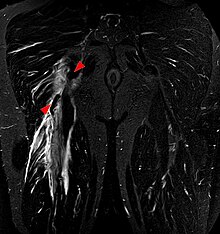Sciocrural muscles
The hamstring muscles , also known as knee flexors , hip joint extensors or back thigh muscles , are a group of muscles that are located on the back of the thigh - dorsal in humans and caudal in animals . In animal anatomy, these muscles are also known as buttock muscles or long ischial muscles . In the Anglo-American literature this muscle group is called ischiocrural muscles or is summarized as hamstring .
The hamstring muscles
- Musculus biceps femoris ("two-headed thigh muscle")
- Musculus semitendinosus ("hemisphere muscle")
- Musculus semimembranosus ("flat tendon muscle")
function
The main functions of the back thigh muscles are hip extension and knee flexion.
The sciocrural muscles can, however, participate in movements that stretch the knee joint, especially during sporting activities such as running and cycling. In cycling, for example, after about 80 ° of the pedaling cycle (measured from top dead center, the highest pedal position), the biceps femoris muscle, but presumably also the mm. semitendinosus and semimembranosus (they have not been included in many studies) do a large part of the propulsive work by putting pressure on the pedals.
The prerequisite for this "paradoxical" effect is guidance or fixation of the foot. The effect is called “paradox” because when the thigh muscles make a contribution to the development of force against gravity, i. d. This is usually done by the knee-extending front thigh muscles .
The phenomenon was discovered in 1903 by the US physiologist Lombard and named after him as the " Lombard paradox ". It has also been proven for sprinting in athletics.
The ischiocrural muscles proprioreceptively relieve the anterior cruciate ligament ( ligamentum cruciatum anterius ) during knee joint extension , as they pull the plateau of the shinbone ( tibia ) backwards opposite the condyle of the thighbone ( femur ).
In addition, the ischiocrural muscles are used as a stabilizer and active antagonist during sprints and jumping movements and show eccentric muscle contractions to ensure safe knee guidance.
Clinical significance
A tear or tear in part or all of the hamstring muscles is a common injury, often seen in sports that involve sudden, abrupt movements, such as walking. B. water skiing or football occurs. The treatment can be surgical or conservative, with the decision for one or the other way depending on the extent of the injury (complete tear or only part).
In veterinary medicine, the hamstring muscles are often used for intramuscular injection .
Individual evidence
- ↑ See for example in Klaus WIEMANN: Specification of LOMBARD's paradox in the function of the ischiocrural muscles during sprinting (PDF; 179 kB)
- ↑ S. Ostermeier et al .: Dynamic measurement of the tension of the anterior and posterior cruciate ligament as a function of the ischiocrural muscles. Meeting Abstract (DGOOC 2004)
- ↑ Glenn Van Crombrugge, Bernard MFM Duvivier, Kris Van Crombrugge, Johan Bellemans, Koen Peers: Hamstring injury prevention in Belgium and English elite football teams Acta Orthopædica Belgica 2019, Volume 85, Issue 3 of September 2019, pages 373-380
- ^ JD Harris, MJ Griesser, TM Best, TJ Ellis: Treatment of proximal hamstring ruptures - a systematic review. In: International journal of sports medicine. Volume 32, Number 7, July 2011, pp. 490-495, ISSN 1439-3964 . doi : 10.1055 / s-0031-1273753 . PMID 21563032 . (Review).
- ↑ JM Linklater, B. Hamilton, J. Carmichael, J. Orchard, DG Wood: Hamstring injuries: anatomy, imaging, and intervention. In: Seminars in musculoskeletal radiology. Volume 14, Number 2, June 2010, pp. 131-161, ISSN 1098-898X . doi : 10.1055 / s-0030-1253157 . PMID 20486024 . (Review).
Web links
- Entry on sciocrural muscles in the Flexikon , a wiki of the DocCheck company


